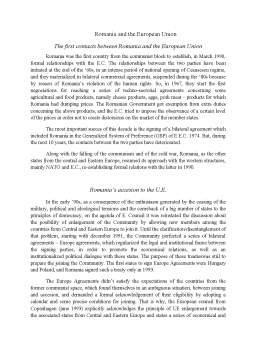Extras din referat
The first contacts between Romania and the European Union
Romania was the first country from the communist block to establish, in March 1990, formal relationships with the E.C. The relationships between the two parties have been initiated at the end of the ‘60s, in an intense period of national opening of Ceausescu regime, and they materialized in bilateral commercial agreements, suspended during the ‘80s because by reason of Romania’s violation of the human rights. So, in 1967, they start the first negociations for reaching a series of techno-sectorial agreements concerning some agricultural and food products, namely cheese products, eggs, pork meat – products for which Romania had dumping prices. The Romanian Government got exemption from extra duties concerning the above products, and the E.C. tried to impose the observance of a certain level of the prices in order not to create distorsions on the market of the member states.
The most important succes of this decade is the signing of a bilateral agreement which included Romania in the Generalized System of Preference (GSP) of E.E.C. 1974. But, during the next 10 years, the contacts between the two parties have deteriorated.
Along with the falling of the communism and of the cold war, Romania, as the other states from the central and Eastern Europe, resumed its approach with the western structures, mainly NATO and E.C., re-establishing formal relations with the latter in 1990.
Romania’s accesion to the U.E.
In the early ‘90s, as a consequence of the enthusiasm generated by the ceasing of the military, political and ideological tensions and the comeback of a big number of states to the principles of democracy, on the agenda of E. Council it was reinstated the discussion about the posibility of enlargement of the Community by allowing new members among the countries from Central and Eastern Europe to join it. Until the clarification/disentanglement of that problem, staritng with december 1991, the Community perfected a series of bilateral agreements – Europe agreements, which regularized the legal and institutional frame between the signing parties, in order to promote the economical relations, as well as an institutionalized political dialogue with these states. The purpose of these treatieswas stiil to prepare the joining the Community. The first states to sign Europe Agreements were Hungary and Poland, and Romania signed such a treaty only in 1993.
The Europe Agreements didn’t satisfy the expectations of the countries from the former communist space, which found themselves in an ambiguous situation, between joining and accesion, and demanded a formal acknowledgement of their eligibility by adopting a calendar and some precise conditions for joining. That is why, the European council from Copenhagen (june 1993) explicitly acknowledges the principle of UE enlargement towards the associated states from Central and Eastern Europe and states a series of economical and political criteria for accesion, also known as the Copenhagen Criteria. According to these, in order to become a member of UE, a candidate state must have:
1. Stable institutions which can ensure/avouch for the democracy, rule of law, repect for the human rights and protection of minorities.
2. A functioning market economy.
3. The capacity of assuming the obligations of a member state, including those concerning the objectives of the political, economic and monetary union of UE
4. A candidate state must enact legislation in order to bring their laws into line with the body of European law (the acquis communautaire).
Romania adopted in 1995 at Snagov, a National Strategy for Preparing the Accession, a document signed by all the political parliamentary parties which established the procedural stages and the actions which were to be taken during the process of aproaching the communitary structures.
Starting with 1998, the candidate states, including Romania, begin to work out national programmes in order to adopt the acquis.
The European Council from Helsinki (dec. 1999) decided the opening of accession negociations with other six candidate countries: Bulgaria, Letonia, Lituania, Malta, Romania and Slovakia. The actual beginning of the negociations would start in february 2000, at the intergovernmental conference from Bruxelles.
The negotiations for accession
The state which wishes to join UE has to present to the Presidency of UE Council an accession form (a letter in which to express the wish to become a member of UE), the UE Council decides if the sollicitant state is given the status of candidate to integration in UE. From the moment the candidature of a state is accepted, it receives help from the Union to prepare itself for accession and it is monitorized to see to what extent it accomplishes the accession criteria. Based on the country reports, drawn by the European Committee, the European Council decides the opening of the negociations for accession. According to the regulations of the Europe Agreement, the dialogue Romania-UE takes place within the frame of the Association Councils, the reunions of the Association Committee and the sectorial Association Subcomittees and mixt Parliamentary Committee Romania – UE
Preview document
Conținut arhivă zip
- Romania and the European Union.doc


















